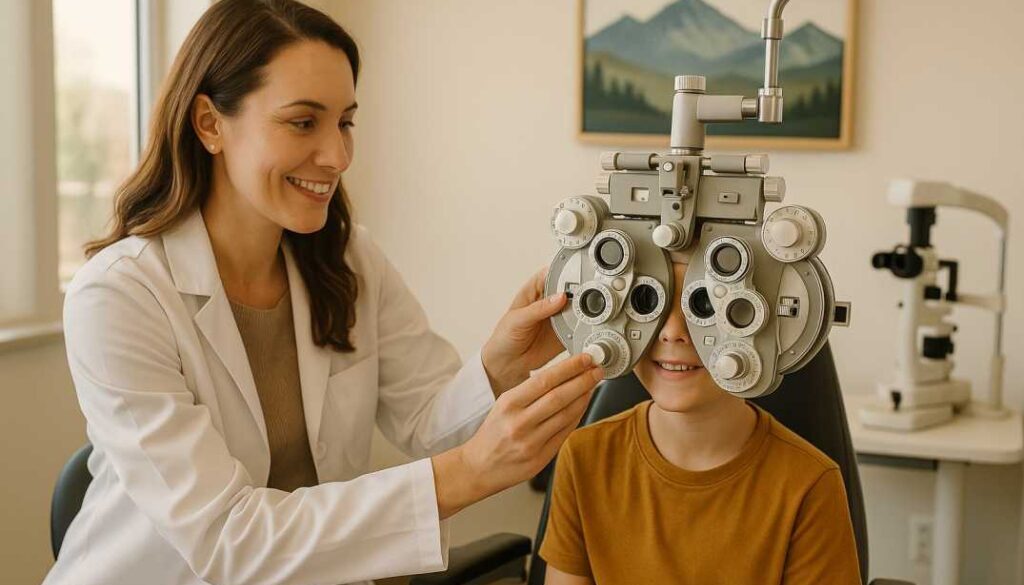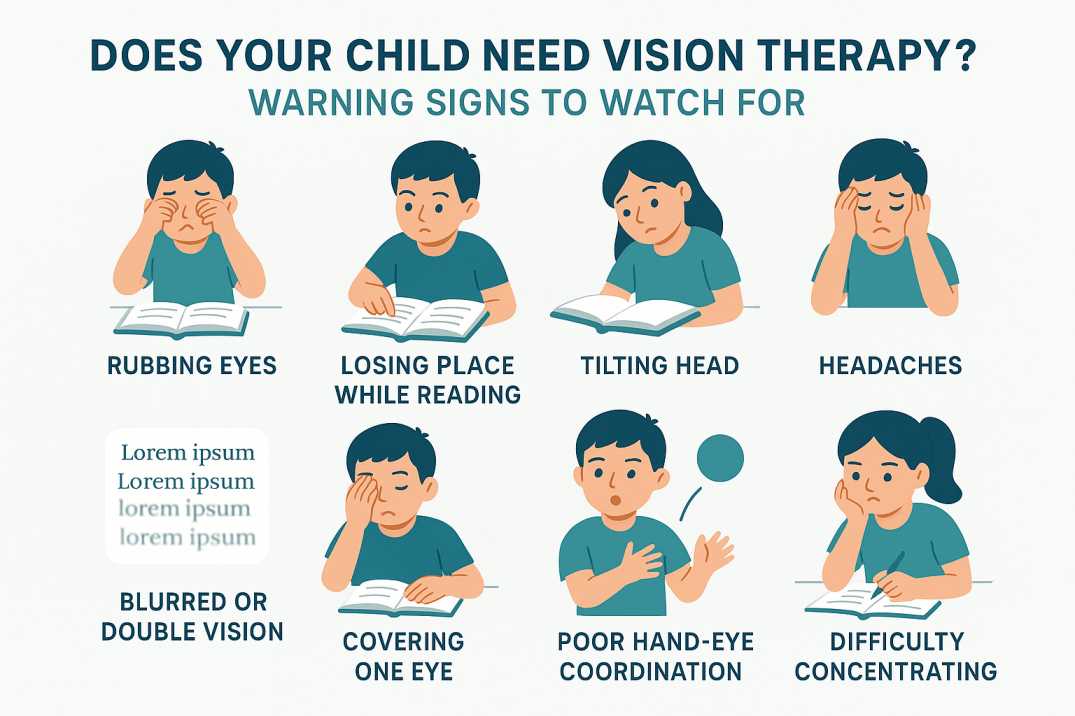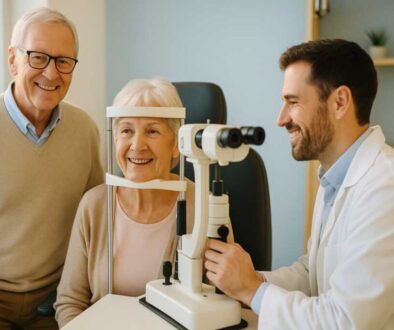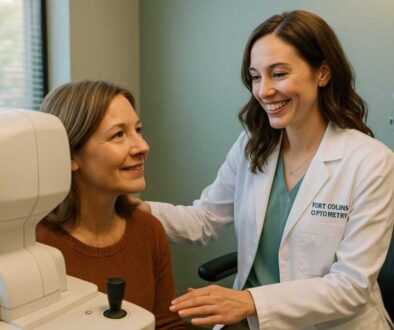Child Vision Therapy Symptoms Guide | Fort Collins Expert
Bottom Line Up Front: If your child struggles with reading, experiences frequent headaches during close work, loses their place while reading, or has trouble with concentration and attention despite having “perfect” 20/20 vision, they may benefit from vision therapy. Research shows that 6.8% of children under 18 have a diagnosed eye and vision condition, with an additional 25% having undetected vision problems significant enough to affect school performance—many of these issues can’t be corrected with glasses alone.
Quick Answer for Busy Parents: The most common signs your child needs vision therapy include losing place while reading, frequent headaches during homework, avoiding reading activities, poor sports performance despite good coordination elsewhere, and difficulty concentrating on visual tasks.
As parents in Fort Collins, we want our children to succeed in school and life. But what happens when your child consistently struggles with reading, homework, or paying attention, even though their regular eye exam shows “perfect” vision? The answer might lie in understanding when your child needs vision therapy and recognizing the specific symptoms that indicate this specialized treatment could help.
What Is Vision Therapy and Why Does My Child Need It?
Vision therapy is a personalized, evidence-based program of exercises and activities designed to improve how your child’s eyes work together and communicate with their brain. Think of it as physical therapy for the visual system—it strengthens the connection between the eyes and brain to enhance visual skills that are crucial for learning and daily activities.
A child needs vision therapy when they have functional vision problems that go beyond what traditional glasses can correct. While glasses address refractive errors (nearsightedness, farsightedness, and astigmatism), vision therapy treats how effectively the eyes track, focus, and work together as a coordinated team.
Related Services: At Poudre Valley Eyecare, we also provide [comprehensive pediatric eye exams], [learning-related vision assessments], and [sports vision evaluations] to ensure your child’s complete visual development.
Key Signs Your Child Needs Vision Therapy: Recognizing Vision Therapy Symptoms in Children
Academic and Reading Difficulties
Understanding vision therapy symptoms in children starts with recognizing academic struggles that seem puzzling when your child has passed routine vision screenings. Parents often wonder, “Does my child need vision therapy?” when they notice these specific indicators:
- Loses place while reading or uses a finger to track across lines
- Skips words or lines when reading aloud
- Reads slowly with poor comprehension despite adequate intelligence
- Avoids reading or homework involving close work
- Complaints that words move or appear to “jump off the page”
- Tilts head or closes one eye while reading or writing
- Has difficulty copying from the board to paper
- Reverses letters or numbers beyond age-appropriate expectations
- Poor reading fluency despite phonics knowledge
Physical Symptoms During Close Work
Children needing vision therapy often experience physical discomfort during visual tasks. These vision therapy symptoms in children include:
- Frequent headaches after reading or doing homework
- Eye strain or fatigue during close work
- Blurred or double vision when reading
- Burning or itchy eyes after visual tasks
- Excessive blinking or squinting while focusing
- Rubbing eyes frequently during or after reading
- Watery eyes during concentrated visual work
- Light sensitivity in the classroom or study environments
Attention and Behavioral Issues
Many children with vision problems are misdiagnosed with ADHD or labeled as having behavioral issues. When determining if your child needs vision therapy, consider these attention-related symptoms:
- Short attention span during visual tasks
- Difficulty concentrating on homework
- Fidgeting or restlessness when required to focus on close work
- Avoiding activities that require sustained visual attention
- Acting out or becoming frustrated during reading time
Coordination and Sports Performance
Vision problems affect more than just academics. Your child needs vision therapy if they experience:
- Struggle with hand-eye coordination in sports
- Have poor depth perception or difficulty judging distances
- Bump into objects or appear clumsy
- Have trouble catching or hitting balls
- Difficulty with balance during physical activities
Common Vision Conditions That Require Vision Therapy
Convergence Insufficiency: The Hidden Learning Disruptor
Convergence insufficiency affects 2% to 13% of children (with most studies citing around 5-7.5% of the population) and represents one of the most common conditions requiring vision therapy. This condition occurs when the eyes struggle to turn inward together effectively to focus on close objects like books, tablets, or homework materials.
Convergence insufficiency symptoms include:
- Eyes that drift outward when reading or doing close work
- Double vision or blurred text during near tasks
- Words appearing to float or move on the page
- Difficulty maintaining focus during sustained near work
- Frequent headaches and eye strain after reading
- Avoidance of homework or reading activities
Research from the National Eye Institute demonstrates that 75% of children with convergence insufficiency experienced significant improvement after completing office-based vision therapy with home reinforcement. Recent 2024 studies continue to support these findings, with children showing measurable improvements in near point of convergence and positive fusional vergence within 12 weeks of treatment.
Amblyopia (Lazy Eye)
When one eye develops significantly weaker vision than the other, amblyopia develops. While traditional patching has long been the standard treatment, recent studies demonstrate that active vision therapy can be equally effective and may provide superior outcomes for older children, particularly in developing depth perception and binocular coordination.
Strabismus (Eye Misalignment)
When eyes don’t align properly, vision therapy can help train the visual system to work together more effectively. This approach is particularly beneficial for intermittent strabismus, where eyes only turn occasionally, and can help prevent the development of amblyopia.
Visual Processing Disorders
Some children can see clearly but struggle to interpret and understand visual information. Vision therapy can help improve visual processing skills essential for reading and learning.
Current Data on Children’s Vision Problems (2024-2025)
Recent statistics highlight the growing concern around pediatric vision issues:
- 6.8% of children under 18 have a diagnosed eye and vision condition
- 25% of school-aged children have vision problems significant enough to affect academic performance
- 3% of children under 18 experience visual impairment or blindness, even with corrective lenses
- 80% of learning in school is presented visually, making clear vision essential
- Fewer than 15% of preschool children receive comprehensive professional eye exams
- School screenings miss 75% of children with vision problems and detect only 20-30% of issues
Digital Age Impact on Children’s Vision
The rise in screen time has created new challenges for developing visual systems:
- Children aged 8-12 average 5.5 hours of daily screen use (excluding schoolwork)
- 65% of Americans report experiencing digital eye strain symptoms
- 80% of youth aged 10-17 who spend extended time on devices report eye discomfort
- Post-COVID studies show a 1.4 to 3 times increase in myopia among school-aged children
- More than half of Americans use screens within an hour of bedtime, affecting sleep quality
The Science Behind Vision Therapy Effectiveness
Recent research strongly supports vision therapy for specific conditions:
Study 1: Korean Elementary School Children (2017)
A comprehensive study published in the Journal of Ophthalmic and Visual Research followed 235 elementary school children in South Korea. After 12 weeks of vision therapy, children with convergence insufficiency showed significant improvement in symptoms and clinical signs, with measurable improvements in near point of convergence and positive fusional vergence.
Study 2: Active Vision Therapy vs. Conventional Patching (2024)
Research published in the Journal of Optometry compared active vision therapy to traditional patching therapy in 65 children with amblyopia. The study found that active vision therapy was equally effective as patching for improving visual acuity and potentially superior for developing stereoacuity (depth perception).
Study 3: Children with Learning Disabilities (2018)
A controlled study examining children with specific learning disorders found that 88% had non-strabismic binocular vision anomalies. After vision therapy, these children showed statistically significant improvements in convergence, accommodation, and overall visual function.
When Standard Eye Exams Miss Signs That Your Child Needs Vision Therapy
Many parents express surprise when learning their child needs vision therapy after being told their vision is “fine” during routine screenings. Understanding vision therapy symptoms in children requires recognizing why traditional screening methods often fall short:
School vision screenings typically assess only:
- Distance visual acuity (the familiar eye chart test)
- Basic color vision detection
- Gross eye alignment observation
These screenings miss up to 75% of children with vision problems and detect only 20-30% of school vision issues. Additionally, studies reveal that 61% of children found to have eye problems through screenings never visit a doctor or receive appropriate follow-up care.
Comprehensive vision exams that effectively detect vision therapy candidates evaluate:
- Eye tracking and movement skills across all directions
- Focusing ability and flexibility at various distances
- Eye teaming and binocular coordination
- Visual processing and perceptual abilities
- Depth perception and spatial awareness
- Sustained visual attention and endurance
What to Expect During a Vision Therapy Evaluation
At Poudre Valley Eyecare, our comprehensive vision therapy evaluation goes far beyond basic vision screening. We assess your child’s complete visual system through:
Initial Assessment
- Detailed case history of symptoms and concerns
- Visual acuity testing at multiple distances
- Refractive error measurement
- Eye health examination
Functional Vision Testing
- Eye movement assessment: How well the eyes track across a page
- Focusing skills: Ability to change focus from near to far
- Eye teaming evaluation: How well both eyes work together
- Visual processing assessment: How the brain interprets visual information
- Depth perception testing: Three-dimensional vision capabilities
Specialized Testing
Based on initial findings, we may conduct additional tests to evaluate specific visual skills related to reading, learning, and daily activities.
Treatment Options: What Vision Therapy Looks Like
Office-Based Vision Therapy
Research consistently shows that office-based vision therapy with home reinforcement is the most effective approach. Treatment typically involves:
- Weekly one-hour sessions with a trained vision therapist
- Customized exercises targeting your child’s specific needs
- Specialized equipment, including prisms, lenses, and computerized training systems
- Progress monitoring to ensure optimal outcomes
Home Reinforcement Activities
Daily home exercises (typically 15-20 minutes) reinforce skills learned during office sessions. These activities are designed to be engaging and age-appropriate for your child.
Duration and Success Rates
Most vision therapy programs require 12-24 weeks to complete, depending on the severity of the condition and your child’s progress. Investment and outcomes represent important considerations for families:
Typical Investment (2024-2025):
- Initial comprehensive vision evaluation: $300-500
- Individual vision therapy sessions: $60-150 per session
- Complete treatment programs: $3,000-4,000 on average
- Insurance coverage: Most plans provide limited or no coverage for vision therapy
Evidence-Based Success Rates:
- 75% of children with convergence insufficiency achieve normal or significantly improved symptoms
- Measurable improvements are typically observed within 6-12 weeks of consistent treatment
- Long-lasting benefits when patients complete the full prescribed program
- Academic performance gains are often reported by parents and teachers
Red Flags: When to Seek Help Immediately for Your Child’s Vision
Contact Poudre Valley Eyecare promptly if your child needs a vision therapy evaluation due to:
- Sudden onset of double vision or eye pain
- Significant regression in academic performance
- New complaints of headaches or visual symptoms
- Persistent eye rubbing or squinting
- Avoiding activities they previously enjoyed
The Cost of Unaddressed Vision Problems
When vision problems go untreated, the consequences extend beyond academics:
Academic Impact
- Lower grades and test scores
- Reduced reading comprehension
- Difficulty with math and science concepts
- Potential for grade retention
Emotional and Social Effects
- Decreased self-confidence
- Frustration and behavioral issues
- Avoidance of visual activities
- Social isolation from sports and activities
Long-term Consequences
- Limited career opportunities
- Ongoing learning difficulties
- Chronic eye strain and headaches
- Reduced quality of life
Making the Decision: How to Determine if Your Child Needs Vision Therapy
If you recognize vision therapy symptoms in children in your child, here’s what to do:
Step 1: Schedule a Comprehensive Vision Evaluation
Contact Poudre Valley Eyecare to schedule a thorough assessment of your child’s visual system. Our experienced team will determine if vision therapy is appropriate for your child’s specific needs.
Step 2: Gather Information
- Document your child’s symptoms and struggles
- Speak with teachers about classroom observations
- Review recent academic performance
- Note any family history of vision problems
Step 3: Consider Professional Recommendations
If vision therapy is recommended, discuss:
- Treatment goals and expected outcomes
- Time commitment and scheduling
- Insurance coverage and payment options
- Home practice requirements
Why Choose Poudre Valley Eyecare for Vision Therapy
With over 25 years of trusted eye care service in Fort Collins, Poudre Valley Eyecare combines extensive experience with cutting-edge technology to provide comprehensive vision therapy services. We understand that every child presents unique visual challenges, and we tailor our approach to meet your family’s specific needs and goals.
Our commitment to excellence includes:
- Thorough evaluations using the latest diagnostic technology and evidence-based protocols
- Personalized treatment plans designed for optimal outcomes
- Convenient Fort Collins location with flexible scheduling options
- Acceptance of Medicare and Medicaid for qualifying services
- Ongoing support and progress monitoring throughout your child’s treatment journey
- Collaboration with teachers and other healthcare providers when beneficial
Resources and Citations
Scientific Research Studies:
1. Effectiveness of Vision Therapy in School Children with Symptomatic Convergence Insufficiency
- Journal of Ophthalmic and Visual Research, 2017
- Link: https://www.ncbi.nlm.nih.gov/pmc/articles/PMC5423373/
- Key Finding: A Study of 235 Korean elementary school children showed significant improvement in convergence insufficiency symptoms after 12 weeks of vision therapy, with measurable improvements in near point of convergence and positive fusional vergence.
2. Impact of Active Vision Therapy Compared to Conventional Patching Therapy on Visual Acuity and Stereoacuity in Children with Amblyopia
- Journal of Optometry, 2024
- Link: https://www.sciencedirect.com/science/article/pii/S1888429623000328
- Key Finding: Research involving 65 children with amblyopia demonstrated that active vision therapy was equally effective as conventional patching for improving visual acuity and potentially superior for developing stereoacuity (depth perception).
3. Convergence Insufficiency Treatment Trial (CITT) – National Eye Institute
- Archives of Ophthalmology, Multiple Studies 2005-2008
- Link: https://www.nei.nih.gov/learn-about-eye-health/eye-conditions-and-diseases/convergence-insufficiency
- Key Finding: Multi-site randomized clinical trial funded by the National Eye Institute found that 75% of children with convergence insufficiency achieved normal or significantly improved symptoms after office-based vision therapy with home reinforcement.
These peer-reviewed studies provide the scientific foundation for the effectiveness of vision therapy in treating various childhood vision conditions. For additional research and clinical guidelines, families can also reference the American Optometric Association’s evidence-based recommendations for comprehensive pediatric eye examinations.
Conclusion: Giving Your Child the Gift of Clear, Comfortable Vision
Recognizing when your child needs vision therapy can be life-changing for their academic success and overall quality of life. The signs are often subtle but significant—from struggling with reading despite good intelligence to experiencing headaches during homework time.
Remember, vision problems don’t always manifest as obvious symptoms. Many children adapt to their visual difficulties and may not complain about discomfort or struggles. That’s why comprehensive vision evaluations are essential, especially if your child is experiencing academic or behavioral challenges.
Take Action Today: If you’ve noticed any vision therapy symptoms in children in your child, don’t wait for the problems to resolve on their own. Early intervention provides the best outcomes, and the skills developed through vision therapy last a lifetime.
At Poudre Valley Eyecare, we’re here to partner with you in your child’s visual development journey. Our comprehensive approach ensures that all vision problems are identified and appropriately treated, giving your child the clear, comfortable vision they need to succeed in school and life.
Ready to help your child succeed? Call Poudre Valley Eyecare or [schedule your child’s comprehensive vision evaluation online]. Our experienced team is dedicated to providing the highest quality vision care for every member of your family.
Contact us today to schedule your child’s comprehensive vision evaluation and discover how vision therapy can unlock their full potential for learning and success.
About Poudre Valley Eyecare: For over 25 years, Poudre Valley Eyecare has served as Fort Collins’ trusted partner in comprehensive eye health. Our experienced team combines advanced diagnostic technology with personalized care to ensure optimal vision outcomes for patients of all ages. We are committed to making quality eye care accessible to every member of our community.
FAQs
-
Watch for reading difficulties, frequent headaches after schoolwork, poor eye tracking while reading, squinting at close work, covering one eye, and difficulty staying focused on visual tasks.
Please note: None of the above should be considered medical advice. If you’re having any concerns about your vision, please reach out to us immediately or see your primary care provider.





